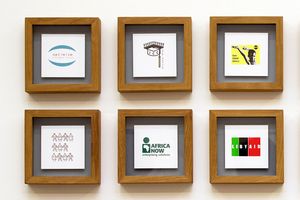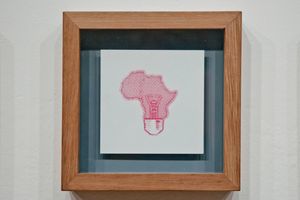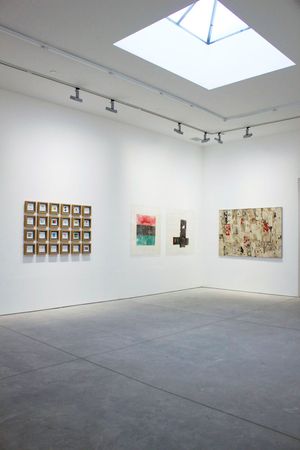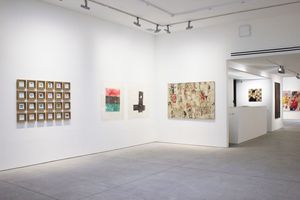Logos Of Non-profit Organisations Working In Kenya (Some of Which Are Imaginary)
2012
Logos of Non Profit Organisations working in Kenya (some of which are imaginary)_01_Installation Image_2012_Documentation_(c)Tattinger Gallery-4
The Exchange: Sam Hopkins And Michela Wrong On Africa’s New Missionaries - How Has Western Aid Shaped Africa And Its Institutions? - Fp Staff
original publicationFor more than two decades, writer, reporter, and Foreign Policy contributor Michela Wrong has covered government corruption, Western aid, and the heroes and villains that created modern Africa. After penning three nonfiction books about the continent, she entered the world of fiction this summer with her first novel, Borderlines, a land-dispute thriller set in a fictionalized Eritrea called North Darrar. This intersection — and, at times, blurring — of fact and fiction in Africa is also the focus of visual artist Sam Hopkins. Raised in Britain and Kenya, Hopkins, named a 2014 Global Thinker, explores in his work the implications of development. At the 2014 Dak’Art biennale in Senegal, he exhibited a screen-print collection of logos of both real and invented international aid organizations, challenging viewers’ perceptions and understanding of these institutions. Wrong and Hopkins recently connected in Foreign Policy’s recording studio in Washington to talk about African aid, art, and literature.
Sam Hopkins: I’m interested in how [aid and nongovernmental] organizations represent themselves in the visual realm. It seems that if we take their logos, there’s sort of a distillation of an ideology: They perpetuate images and notions of suffering and charity, which most people who spend time in any African country know represent only a small part of reality. Nevertheless, these organizations seem to trade off a stereotypical view of the entire state of Africa as the face of need, which is something I think is not fixed with my anecdotal experience of growing up in Kenya.
Michela Wrong: I’ve been coming and going between London and Nairobi for many years now, and every time I take that British Airways flight, it’s packed. And it’s packed with aid workers. Recently, there were two people from two separate refugee organizations behind me talking about refugees and refugee camps they had known. Then there was somebody who was offering scholarships for engineering students. There was someone who was involved with a mission, some charitable venture that was being run by an American evangelical mission. Nairobi is a very peculiar city; it’s dominated by these large white Land Cruisers with the logos that [you have] dedicated some of [your] art to. I think Nairobi, of all the cities in Africa I’ve ever visited, is the most affected by this syndrome where it’s NGO- ville exemplified. And it’s not healthy, in my view, that what we’re seeing is this sort of legacy, almost, of the missionaries. This is the new missionary industry.

Logos of Non Profit Organisations working in Kenya (some of which are imaginary)_01_Installation Image_2012_Documentation_(c)Tattinger Gallery-4
SH: Unless you’ve been here and you’ve experienced it — being stuck in traffic jams and seeing Land Cruiser after Land Cruiser go past you with all these logos — then it’s difficult to get a sense of how overwhelming it is. For a while, I was running a grassroots media collective in the outskirts of Nairobi. In the editorial meetings, the 16- or 17-year-old guys would say, “I want to make something about water and sanitation” or “I want to make something about HIV/AIDS.” They’re not saying, “I’d like to make a film about the river at the end of my garden.” They’ve assimilated the whole lexicon of development — it’s understandable, because it’s connected with power, it’s connected with funding, it’s connected with expectations of what people should be making films about. But what shocked me is that it’s also shaping how people perceive their own world.
MW: I wrote a nonfiction book about Eritrea, and then I wrote Borderlines, which is the sort of fictional take on it, although the country in the novel is not called Eritrea for various complicated reasons. But I think the reason I keep being attracted to Eritrea is this is a country that when it achieved independence in 1993 just said, “We’re not going to play this NGO game, and we’re not going to play the aid-industry game. We think it’s emasculating; we think it’s deeply corrupting of morale, of national identity, of independence; and we’re going to do our own thing.” But Eritrea now is a country that’s sadly sending migrants flooding into Europe. The people are so unhappy with the state of play in their own home country. But I was always very drawn to it as a writer. The Eritrean government runs the show; they are in charge of their own destiny. They are running famine relief. They’re very efficient on the health front and on primary education. They score very well on these Millennium Development Goals, and it’s just really refreshing when you see a government that isn’t playing this game. But in Eritrea, there’s basically this really stifling sense of living in what is a very efficient police state. There are certain states now in Africa which can deliver security and stability, and you know your cows will be vaccinated, health care’s improving, primary education’s on the up, everyone’s becoming literate. But they are claustrophobic, horrible places to live. It’s not enough to just deliver on that side of things.
SH: I’m quite conscious I’m not a developmental economist. I’m not a sociologist. I’m not an aid worker. I’m a visual artist, so my critique is anchored into a very specific and quite small space. I don’t want to make blanket dismissals of how all NGOs operate because in a way that sort of perpetuates to me a situation where people make a lot of blanket judgments about what’s happening on the African continent.

Logos of Non Profit Organisations working in Kenya (some of which are imaginary)_01_Installation Image_2012_Documentation_(c)Tattinger Gallery-3
Looking at the logos is sort of a distillation of that. Sort of connected to that, when I went to buy a copy of your book in Nairobi, [the bookstore assistant] took me to the nonfiction section, but said, “Let me ask you: Is this a nonfiction book, or is this fiction?” I said, “It’s a work of fiction,” and she said, “Yeah, but it seems like a true story.” It was quite a beautiful moment because I know your nonfiction work; it made me ask myself about how a critique could be made within a space of fiction, in a different way from the critique being made within the space of nonfiction.
MW: If you don’t come from a reading culture, if you grew up in a house where there were no books and went to a primary school where there were no books, then as an adult you’re not going to read. This has lead to an emphasis across Africa in which people want to build up a reading habit and a reading culture based on this realization that books open up your world, connect you with the world. But still there are only a very few African novelists who get recognized in the West, like Chimamanda Ngozi Adichie or Taiye Selasi or NoViolet Bulawayo. Their stuff is celebrated and sells in hundreds of thousands, in some cases. But that’s in the West. Their sales figures in Africa are not yet there, so these African writers are very wary and worried that they are going to lose touch with their own communities. The question then becomes: Who are these writers writing for?
SH: I’m really interested in this emerging book culture in Nairobi. There’s actually a group of people who started a book-swap club called the World’s Loudest Library. And they’re not upper-middle-class people that can afford to buy books; they buy books on the secondhand market where you get them between 50 cents and a dollar, and once a month they will have a party where everyone brings a book. You put the book you bring in a bin, and then you take another book back with you. A lot of the reading culture is maybe hampered by a problem of supply.
This conversation has been condensed for publication.

Logos of Non Profit Organisations working in Kenya (some of which are imaginary)_01_Installation Image_2012_Documentation_(c)Hopkins-1
Beyond the “NGO Aesthetic” - Jennifer Bajorek/Social Text
Deconstructing Logos - Kimani wa Njogu/Contemporary &
This Exhibit Will Permanently Redefine Your Idea of Art From Africa - Scher/Bowery and Bowery
download text as PDF
